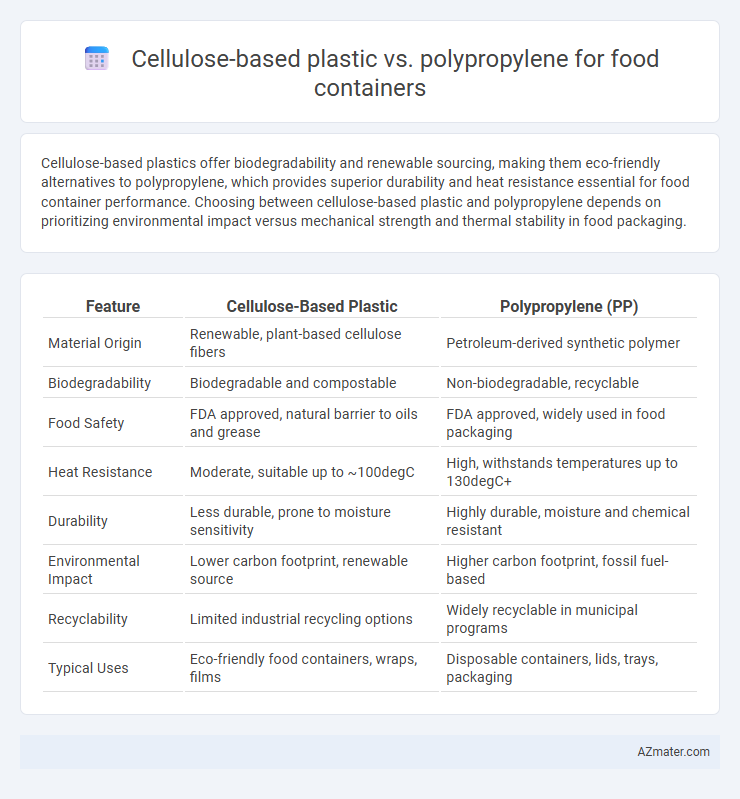Cellulose-based plastics offer biodegradability and renewable sourcing, making them eco-friendly alternatives to polypropylene, which provides superior durability and heat resistance essential for food container performance. Choosing between cellulose-based plastic and polypropylene depends on prioritizing environmental impact versus mechanical strength and thermal stability in food packaging.
Table of Comparison
| Feature | Cellulose-Based Plastic | Polypropylene (PP) |
|---|---|---|
| Material Origin | Renewable, plant-based cellulose fibers | Petroleum-derived synthetic polymer |
| Biodegradability | Biodegradable and compostable | Non-biodegradable, recyclable |
| Food Safety | FDA approved, natural barrier to oils and grease | FDA approved, widely used in food packaging |
| Heat Resistance | Moderate, suitable up to ~100degC | High, withstands temperatures up to 130degC+ |
| Durability | Less durable, prone to moisture sensitivity | Highly durable, moisture and chemical resistant |
| Environmental Impact | Lower carbon footprint, renewable source | Higher carbon footprint, fossil fuel-based |
| Recyclability | Limited industrial recycling options | Widely recyclable in municipal programs |
| Typical Uses | Eco-friendly food containers, wraps, films | Disposable containers, lids, trays, packaging |
Introduction to Food Container Materials
Cellulose-based plastics, derived from renewable plant fibers, offer biodegradable and compostable alternatives to conventional polypropylene in food container applications. Polypropylene, a petroleum-based polymer, provides excellent durability, chemical resistance, and high-temperature tolerance, making it widely used for food packaging. Both materials present unique benefits and challenges regarding environmental impact, safety, and performance standards in the food container industry.
Overview of Cellulose-Based Plastics
Cellulose-based plastics are derived from natural polymers, primarily cellulose obtained from plant fibers, making them biodegradable and renewable alternatives to traditional plastics like polypropylene. These bioplastics exhibit excellent oxygen barrier properties, crucial for maintaining food freshness and extending shelf life in containers. While polypropylene offers durability and heat resistance, cellulose-based plastics provide enhanced environmental benefits by reducing plastic pollution and facilitating compostability.
Understanding Polypropylene in Food Packaging
Polypropylene (PP) is widely used in food packaging due to its excellent chemical resistance, high melting point (around 160degC), and strong barrier properties against moisture. It offers durability and flexibility, making it suitable for various containers that require heat sterilization or microwave use. Compared to cellulose-based plastics, polypropylene provides longer shelf life and superior protection for food products, despite cellulose's advantage of being biodegradable and derived from renewable resources.
Environmental Impact: Cellulose vs Polypropylene
Cellulose-based plastics for food containers offer significant environmental benefits due to their biodegradability and renewable origins, reducing plastic pollution and reliance on fossil fuels compared to polypropylene. Polypropylene, a petroleum-derived plastic, contributes to persistent environmental pollution and has a higher carbon footprint during production and disposal. The compostability and lower energy consumption of cellulose-based plastics make them a more sustainable choice for food packaging in terms of environmental impact.
Biodegradability and Compostability Comparison
Cellulose-based plastics exhibit superior biodegradability and compostability compared to polypropylene, breaking down more rapidly under industrial composting conditions within 90 to 180 days. Polypropylene, a conventional petroleum-based polymer, can take over 400 years to degrade and is not typically compostable, posing significant environmental persistence. This makes cellulose-based containers a preferred option for sustainable food packaging, aligning with biodegradation timelines that minimize landfill accumulation and ecological impact.
Food Safety and Chemical Leaching Concerns
Cellulose-based plastics offer superior biodegradability and lower risk of harmful chemical leaching compared to polypropylene when used in food containers, enhancing food safety. Polypropylene containers can release additives like phthalates and other plasticizers, especially under heat, posing potential health risks. Cellulose-based materials, derived from natural fibers, reduce exposure to synthetic chemicals, making them a safer choice for storing food products.
Durability and Performance Metrics
Cellulose-based plastics offer biodegradability and moderate durability, but they generally exhibit lower resistance to heat and mechanical stress compared to polypropylene, which delivers superior tensile strength and thermal stability ideal for food container applications. Polypropylene containers maintain structural integrity at temperatures up to 120degC and possess high impact resistance, ensuring reliable performance during transport and microwave use. While cellulose-based plastics excel in environmental sustainability, polypropylene remains the preferred choice for durability and long-term food preservation due to its robust performance metrics.
Cost Analysis and Market Availability
Cellulose-based plastics for food containers generally incur higher production costs due to raw material extraction and processing complexities compared to polypropylene, which benefits from established large-scale manufacturing and petrochemical feedstock availability. Polypropylene dominates the market with widespread availability, competitive pricing, and strong supply chains, making it the preferred choice for cost-sensitive food packaging applications. Despite cellulose-based plastics' environmental advantages, their limited commercial scale and variability in raw material supply contribute to higher market prices and restricted availability.
Regulatory Standards and Certifications
Cellulose-based plastics for food containers comply with stringent FDA and EU food contact material regulations, emphasizing biodegradability and low chemical migration, often certified under ASTM D6400 and EN 13432 for compostability. Polypropylene (PP) meets FDA 21 CFR 177.1520 standards, ensuring thermal stability and inertness, with NSF and ISO 22000 certifications supporting food safety and hygiene requirements. Both materials must undergo rigorous compliance testing for heavy metals, migration limits, and overall safety to meet global food packaging regulatory frameworks.
Future Trends in Sustainable Food Containers
Cellulose-based plastic is gaining traction as a biodegradable alternative to polypropylene in sustainable food containers, driven by increasing consumer demand for eco-friendly packaging. Innovations in cellulose nanofiber technology enhance the material's strength and barrier properties, making it more competitive with polypropylene's durability and cost-effectiveness. Future trends emphasize renewable raw materials and improved compostability, positioning cellulose-based plastics as a key solution for reducing plastic waste in the food packaging industry.

Infographic: Cellulose-based plastic vs Polypropylene for Food container
 azmater.com
azmater.com